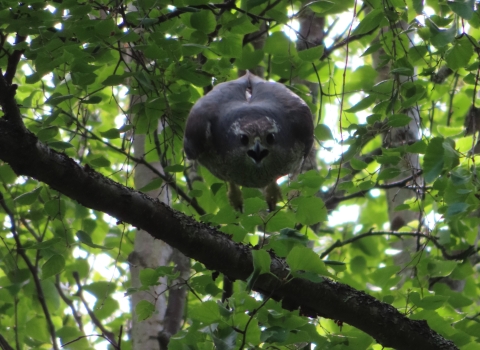What is the U.S. Fish and Wildlife Service proposing?
After conducting a thorough species status review, the U.S. Fish and Wildlife Service proposes placing three freshwater mussels, the Cumberland moccasinshell, Tennessee clubshell, and Tennessee pigtoe, on the federal list of threatened and endangered species. All three mussels are being proposed as endangered.
What is the Cumberland moccasionshell?
Cumberland moccasinshell is a freshwater mussel that grows to about 2.5 inches long and lives 5-20 years. It prefers riffles, shoals, and high gradient streams with stable stream bottoms dominated by coarse sand, gravel, and cobble. Individuals are often found in habitat less than three feet deep in small to medium sized rivers. It’s found in five states: Alabama, Georgia, Kentucky, Tennessee, and Virginia. Today, there are 65 known populations of Cumberland moccasinshell, with 87 populations believed extinct. It lives in the Tennessee and Cumberland River basins.
What is the Tennessee clubshell?
The Tennessee clubshell is a freshwater mussel that grows to around 3.5 inches long, and lives 30-50 years. It prefers riffles, shoals, and high gradient streams with stable stream bottoms dominated by coarse sand, gravel, and cobble. Individuals are often found in habitat less than three feet deep in small to medium sized rivers. It’s found in six states: Alabama, Georgia, Kentucky, Tennessee, and Virginia. Today there are 64 known populations with 83 believed extinct. It lives in the Tennessee and Cumberland River basins.
What is the Tennessee pigtoe?
The Tennessee pigtoe is a freshwater mussel that grows to around 3.5 inches long, and lives 30-50 years. It prefers riffles, shoals, and high gradient streams with stable stream bottoms dominated by coarse sand, gravel, and cobble. Individuals are often found in habitat less than three feet deep in small to medium sized rivers. It’s found in six states: Alabama, Georgia, Mississippi, North Carolina, Tennessee, and Virginia. Today there are 63 known populations of Tennessee pigtoe, with 51 believed extinct. It lives in the Tennessee River basin.
What threats brought these mussels to this point?
These mussels have suffered impacts from negative influences commonly found in central and eastern U.S. streams, including habitat degradation or loss from a variety of sources, poorly managed agriculture and development, and site-specific threats from genetic isolation and invasive species invasive species
An invasive species is any plant or animal that has spread or been introduced into a new area where they are, or could, cause harm to the environment, economy, or human, animal, or plant health. Their unwelcome presence can destroy ecosystems and cost millions of dollars.
Learn more about invasive species .
What protections would these mussels receive by being on the threatened and endangered species list?
Efforts to conserve them have increased eligibility for funding.
Increased restrictions on trade and transport.
Prohibition on take without a permit, i.e., harass, harm, pursue, hunt, shoot, wound, kill, trap capture, or collect, or attempt to engage in any such conduct.
Consideration in actions that are federally authorized, funded, or carried out, and assurance that such actions won’t jeopardize the existence of a species.
Increased awareness.
How did the Service come to this conclusion?
The Service compiled and analyzed data for these wide-ranging species. The Service reached out to species and habitat experts, including staff in its own field offices, state wildlife agencies for each of the states when the mussels occur, and university and agency researchers and staff who work with these species to compile a range-wide status of these species and project their status into the future. These status assessments subsequently went through a peer-review process. For each of these species, this represents the first time such a comprehensive, range-wide investigation into their status has been conducted.
How do I provide comments on the proposed listing?
We will accept comments received or postmarked on or before October 23. To submit comments electronically, go to http://www.regulations.gov. In the search box, enter FWS-R4-ES-2023-0112; which is the docket number for this rulemaking. Then, click on the search button. On the resulting page, in the search panel on the left side of the screen, under the “Document Type” heading, check the proposed rule box to locate this document. You may submit a comment by clicking on “Comment Now!” Submit comments via mail or hand-delivery to Public Comments Processing, Attn: FWS-R4-ES-2023-0112; U.S. Fish and Wildlife Service, MS: JAO/1N, 5275 Leesburg Pike, Falls Church, VA 22041–3803. We request that you send comments only by the methods described above. We will post all comments on http://www.regulations.gov.
Why should we care about mussels?
Sensitive to pollution, native mussels are indicators of broader stream health – vibrant mussel populations typically reflect a healthy stream. In addition to being indicators of stream health, mussels clean water as they feed, filtering their food from the water column, and with it, sediment and other pollutants. There are more than 900 species worldwide, with North America being a global center of mussel diversity, with about 300 species. Despite the high amount of diversity, 65 percent of North American freshwater mussel species are imperiled.



